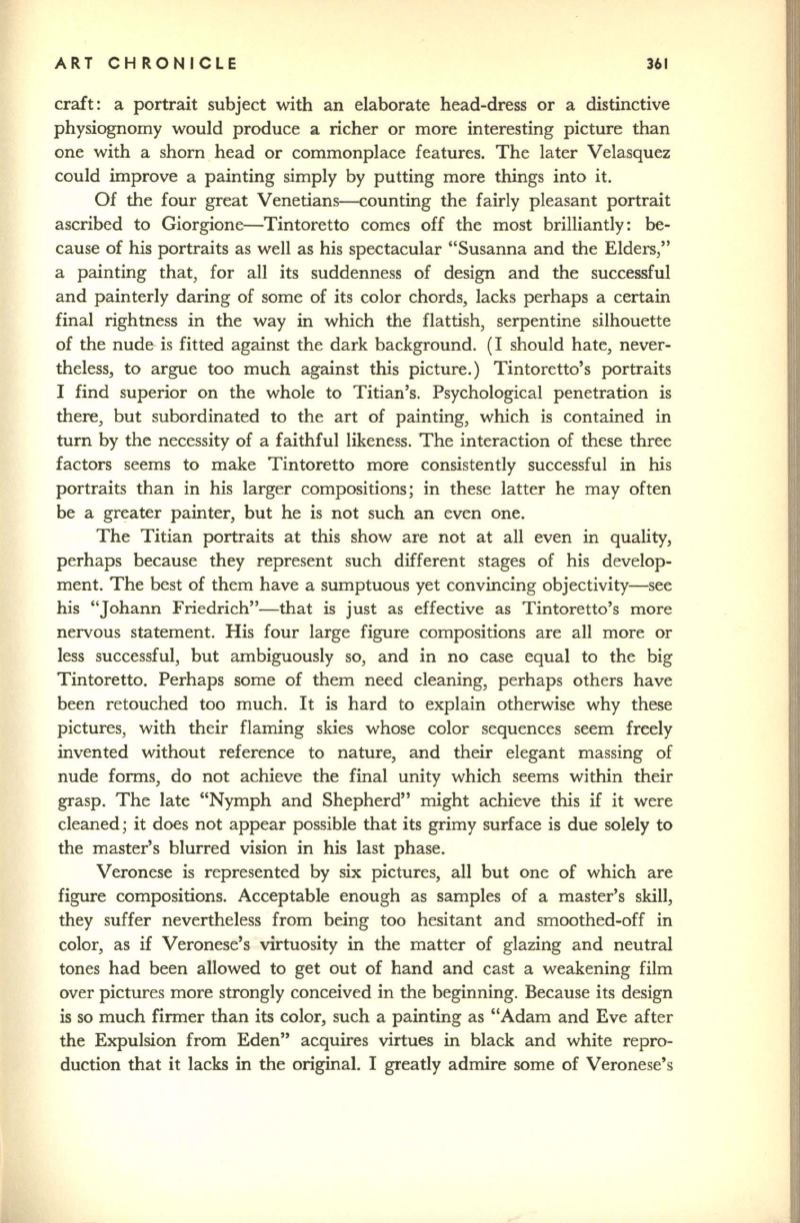
ART CHRONICLE
361
craft: a portrait subject with an elaborate head-dress or a distinctive
physiognomy would produce a richer or more interesting picture than
one with a shorn head or commonplace features. The later Velasquez
could improve a painting simply by putting more things into it.
Of the four great Venetians-counting the fairly pleasant portrait
ascribed to Giorgione-Tintoretto comes off the most brilliantly:
be–
cause of his portraits as well as his spectacular "Susanna and the Elders,"
a painting that, for all its suddenness of design and the successful
and painterly daring of some of its color chords, lacks perhaps a certain
final rightness in the way in which the flattish, serpentine silhouette
of the nude is fitted against the dark background. (I should hate, never–
theless, to argue too much against this picture.) Tintoretto's portraits
I find superior on the whole to Titian's. Psychological penetration is
there, but subordinated to the art of painting, which is contained in
turn by the necessity of a faithful likeness. The interaction of these three
factors seems to make Tintoretto more consistently successful in his
portraits than in his larger compositions; in these latter he may often
be a greater painter, but he is not such an even one.
The Titian portraits at this show are not at all even in quality,
perhaps because they represent such different stages of his develop–
ment. The best of them have a sumptuous yet convincing objectivity-see
his "Johann Friedrich"-that is just as effective as Tintoretto's more
nervous statement. His four large figure compositions are all more or
less successful, but ambiguously so, and in no case equal to the big
Tintoretto. Perhaps some of them need cleaning, perhaps others have
been retouched too much. It is hard to explain otherwise why these
pictures, with their flaming skies whose color sequences seem freely
invented without reference to nature, and their elegant massing of
nude forms, do not achieve the final unity which seems within their
grasp. The late "Nymph and Shepherd" might achieve this if it were
cleaned; it does not appear possible that its grimy surface is due solely to
the master's blurred vision in his last phase.
Veronese is represented by six pictures, all but one of which are
figure compositions. Acceptable enough as samples of a master's skill,
they suffer nevertheless from being too hesitant and smoothed-off in
color, as if Veronese's virtuosity in the matter of glazing and neutral
tones had been allowed to get out of hand and cast a weakening film
over pictures more strongly conceived in the beginning. Because its design
is so much firmer than its color, such a painting as "Adam and Eve after
the Expulsion from Eden" acquires virtues in black and white repro–
duction that it lacks in the original. I greatly admire some of Veronese's


